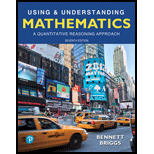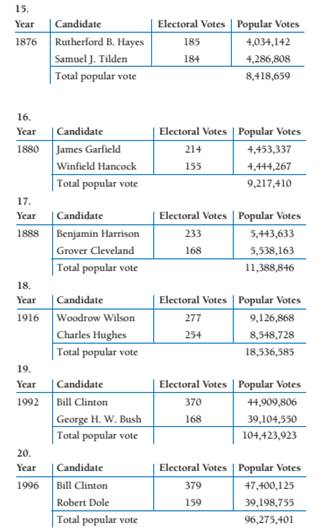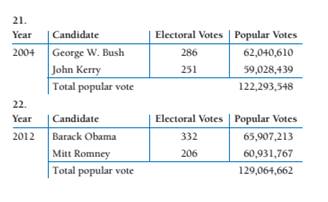
Using & Understanding Mathematics: A Quantitative Reasoning Approach (7th Edition)
7th Edition
ISBN: 9780134705187
Author: Jeffrey O. Bennett, William L. Briggs
Publisher: PEARSON
expand_more
expand_more
format_list_bulleted
Concept explainers
Textbook Question
Chapter 12.A, Problem 20E
Presidential Elections. The following tables give the popular and electoral votes for the two major candidates for various presidential elections. The total popular vote count including votes
that went to other candidates is also given. All electoral votes are shown.
- Compute each candidate's percentage of the total popular vote. Did either receive a popular majority?
- Compute each candidate’s percentage of the electoral vote. Wasthe electoral winner also the winner of the popular vote?


Expert Solution & Answer
Want to see the full answer?
Check out a sample textbook solution
Students have asked these similar questions
Which degenerate conic is formed when a double cone is sliced through the apex by a plane parallel to the slant edge of the cone?
For the problem below, what are the possible solutions for x? Select all that apply.
2
x²+8x +11 = 0
x2+8x+16 =
(x+4)² = 5
1116
For the problem below, what are the possible solutions for x? Select all that apply.
x² + 12x - 62 =
0
x² + 12x + 36 = 62 + 36
(x+6)² = 98
Chapter 12 Solutions
Using & Understanding Mathematics: A Quantitative Reasoning Approach (7th Edition)
Ch. 12.A - Prob. 1QQCh. 12.A - Prob. 2QQCh. 12.A - Prob. 3QQCh. 12.A - Prob. 4QQCh. 12.A - Prob. 5QQCh. 12.A - Prob. 6QQCh. 12.A - Prob. 7QQCh. 12.A - Prob. 8QQCh. 12.A - 9. Study Table 12.5. Which candidate received the...Ch. 12.A - 10. What is the primary lesson of the preference...
Ch. 12.A - 1. What is majority rule? When can it definitively...Ch. 12.A - Prob. 2ECh. 12.A - What is a filibuster? What percentage of the vote...Ch. 12.A - Prob. 4ECh. 12.A - Prob. 5ECh. 12.A - Prob. 6ECh. 12.A - Prob. 7ECh. 12.A - Prob. 8ECh. 12.A - Prob. 9ECh. 12.A - Prob. 10ECh. 12.A - 11. Herman won a plurality of the vote, but Hanna...Ch. 12.A - Fred beat Fran using the point system (Borda...Ch. 12.A - 13. Candidate Reagan won the popular vote for the...Ch. 12.A - Prob. 14ECh. 12.A - Prob. 15ECh. 12.A - Prob. 16ECh. 12.A - Prob. 17ECh. 12.A - Prob. 18ECh. 12.A - Prob. 19ECh. 12.A - Presidential Elections. The following tables give...Ch. 12.A - Prob. 21ECh. 12.A - Prob. 22ECh. 12.A - Prob. 23ECh. 12.A - Presidential Elections. The following tables give...Ch. 12.A - 23. Super Majorities.
a. Of the 100 senators in...Ch. 12.A - 24. Super Majorities.
a. According to the bylaws...Ch. 12.A - Prob. 27ECh. 12.A - Prob. 28ECh. 12.A - Prob. 29ECh. 12.A - Prob. 30ECh. 12.A - Prob. 31ECh. 12.A - Prob. 32ECh. 12.A - 31—34. Interpreting Preference Schedules. Answer...Ch. 12.A - 31—34. Interpreting Preference Schedules. Answer...Ch. 12.A - 31—34. Interpreting Preference Schedules. Answer...Ch. 12.A - Prob. 36ECh. 12.A - Prob. 37ECh. 12.A - Prob. 38ECh. 12.A - Prob. 39ECh. 12.A - Prob. 40ECh. 12.A - Prob. 41ECh. 12.A - How Close Was 2016? Consider Table 12.3 which...Ch. 12.A - Prob. 43ECh. 12.A - Prob. 44ECh. 12.A - Prob. 45ECh. 12.A - Prob. 46ECh. 12.A - Condorcet Winner. If a candidate wins all...Ch. 12.A - 45. Condorcet Paradox. Consider the following...Ch. 12.A - 46. Pairwise Comparisons Question.
a. How many...Ch. 12.A - Prob. 50ECh. 12.A - Prob. 51ECh. 12.A - Prob. 52ECh. 12.A - Prob. 53ECh. 12.A - Prob. 54ECh. 12.A - Sports Polls. Most men’s and women’s major college...Ch. 12.A - Elections Around the World. Many countries have...Ch. 12.B - l. How many of the four fairness criteria (see p....Ch. 12.B - Prob. 2QQCh. 12.B - Prob. 3QQCh. 12.B - Prob. 4QQCh. 12.B -
5. Suppose that Berman is declared the winner of...Ch. 12.B - 6. Suppose that Freedman is declared the winner of...Ch. 12.B - 7. Notice that if Goldsmith dropped out, Freedman...Ch. 12.B - Prob. 8QQCh. 12.B - Which of the following is not an advantage of...Ch. 12.B - Prob. 10QQCh. 12.B - Briefly summarize each of the four fairness...Ch. 12.B - Prob. 2ECh. 12.B - What is approval voting? How is it different from...Ch. 12.B - Prob. 4ECh. 12.B - Prob. 5ECh. 12.B - Prob. 6ECh. 12.B - Prob. 7ECh. 12.B - Prob. 8ECh. 12.B - Plurality and Criterion 1. Explain in words why...Ch. 12.B - 10. Plurality and Criterion 2. Consider the...Ch. 12.B - 11. Plurality and Criterion 2. Devise a preference...Ch. 12.B - Prob. 12ECh. 12.B - Plurality and Criterion 4. Suppose the plurality...Ch. 12.B - Prob. 14ECh. 12.B - Runoff Methods and Criterion 1. Explain in words...Ch. 12.B - Prob. 16ECh. 12.B - Prob. 17ECh. 12.B - Sequential Runoff and Criterion 2. Devise a...Ch. 12.B - Prob. 19ECh. 12.B - Prob. 20ECh. 12.B - Prob. 21ECh. 12.B - Prob. 22ECh. 12.B - Point System and Criterion 1. Devise your own...Ch. 12.B - 24. Point System and Criterion 2. Suppose the...Ch. 12.B - 25. Point System and Criterion 2. Devise a...Ch. 12.B - Prob. 26ECh. 12.B - Prob. 27ECh. 12.B - Prob. 28ECh. 12.B - Prob. 29ECh. 12.B - Prob. 30ECh. 12.B - Prob. 31ECh. 12.B - Pairwise Comparisons and Criterion 4. Suppose the...Ch. 12.B - Prob. 33ECh. 12.B - Approval Voting. Suppose that Candidates A and B...Ch. 12.B - Prob. 35ECh. 12.B - Power Voting. Imagine that a small company has...Ch. 12.B - 37-41: Electoral Power. Use the table below to...Ch. 12.B - 37-41: Electoral Power. Use the table below to...Ch. 12.B - Prob. 39ECh. 12.B - Prob. 40ECh. 12.B - Prob. 41ECh. 12.B - Prob. 42ECh. 12.B - Prob. 43ECh. 12.B - Prob. 44ECh. 12.B - Prob. 45ECh. 12.B - Prob. 46ECh. 12.B - Prob. 47ECh. 12.B - Prob. 48ECh. 12.B - Prob. 49ECh. 12.B - Prob. 50ECh. 12.B - Prob. 51ECh. 12.B - 52. Swing Votes. Suppose that the following...Ch. 12.B - Prob. 53ECh. 12.B - Other Fairness Criteria. The fairness criteria...Ch. 12.B - Prob. 55ECh. 12.B - Power Voting and Coalitions. Use the Web...Ch. 12.B - General Voting Power. Find the news report about...Ch. 12.B - Prob. 58ECh. 12.C - Prob. 1QQCh. 12.C - Prob. 2QQCh. 12.C - Prob. 3QQCh. 12.C - 4. Suppose that, in 2030, the census shows that...Ch. 12.C - 5. Consider a school district with 50 schools,...Ch. 12.C - 6. Consider the school district described in...Ch. 12.C - Prob. 7QQCh. 12.C - Prob. 8QQCh. 12.C - Prob. 9QQCh. 12.C - Prob. 10QQCh. 12.C - Prob. 1ECh. 12.C - Prob. 2ECh. 12.C - Prob. 3ECh. 12.C - What is the Alabama paradox? What other paradoxes...Ch. 12.C - Prob. 5ECh. 12.C - What is the quota criterion? Why are violations of...Ch. 12.C - 7. Briefly describe how Webster’s method and the...Ch. 12.C - 8. Explain why Webster’s method and the...Ch. 12.C - is the president of a large company with 12...Ch. 12.C - 10. Charlene is the head judge in a figure skating...Ch. 12.C - Prob. 11ECh. 12.C - Prob. 12ECh. 12.C - Prob. 13ECh. 12.C - Prob. 14ECh. 12.C - Prob. 15ECh. 12.C - Prob. 16ECh. 12.C - Prob. 17ECh. 12.C - 15-18: State Representation. The following table...Ch. 12.C - 19. Standard Quotas in Business. A large company...Ch. 12.C - 20. Standard Quota in Education. Capital...Ch. 12.C - Prob. 21ECh. 12.C - Prob. 22ECh. 12.C - Prob. 23ECh. 12.C - Prob. 24ECh. 12.C - Prob. 25ECh. 12.C - Prob. 26ECh. 12.C - Prob. 27ECh. 12.C - Prob. 28ECh. 12.C - Prob. 29ECh. 12.C - Prob. 30ECh. 12.C - 29-32: Jefferson's Method. Apply Jefferson's...Ch. 12.C - Jefferson's Method. Apply Jefferson's method to...Ch. 12.C - 33. Webster’s Method. Use Webster’s method to...Ch. 12.C - 34. Webster’s Method. Use Webster’s method to...Ch. 12.C - Prob. 35ECh. 12.C - Prob. 36ECh. 12.C - Prob. 37ECh. 12.C - Prob. 38ECh. 12.C - Comparing Methods. Assume 100 delegates are to be...Ch. 12.C - Prob. 40ECh. 12.C - Prob. 41ECh. 12.C - 39-42: Comparing Methods. Assume 100 delegates are...Ch. 12.C - 43-46: Non-House Apportionments. The following...Ch. 12.C - 43-46: Non-House Apportionments. The following...Ch. 12.C - 43-46: Non-House Apportionments. The following...Ch. 12.C - Prob. 46ECh. 12.C - Prob. 47ECh. 12.C - Prob. 48ECh. 12.C - Prob. 49ECh. 12.D - Prob. 1QQCh. 12.D - Prob. 2QQCh. 12.D - 3. If we compare results in presidential elections...Ch. 12.D - 4. In 2010, Republicans in North Carolina received...Ch. 12.D - Prob. 5QQCh. 12.D - Prob. 6QQCh. 12.D - Prob. 7QQCh. 12.D - Prob. 8QQCh. 12.D - Prob. 9QQCh. 12.D - Prob. 10QQCh. 12.D - What is redistricting, and when must it be done?Ch. 12.D - 2. How has the competitiveness of elections for...Ch. 12.D - 3. What is gerrymandering? Where does this term...Ch. 12.D - 4. Briefly describe how the drawing of boundaries...Ch. 12.D - What requirements must be met in drawing district...Ch. 12.D - Briefly describe two ideas for reforming the...Ch. 12.D - In the last election in my home state, 48% of the...Ch. 12.D - Prob. 8ECh. 12.D - Polls show that half voters in our state plan to...Ch. 12.D - Prob. 10ECh. 12.D - Prob. 11ECh. 12.D - Prob. 12ECh. 12.D - Redistricting and House Elections. The 2010 census...Ch. 12.D - Prob. 14ECh. 12.D - Redistricting and House Elections. The 2010 census...Ch. 12.D - 13-17: Redistricting and House Elections. The 2010...Ch. 12.D - Redistricting and House Elections. The 2010 census...Ch. 12.D -
18-23: Average and Extreme Districts. Consider...Ch. 12.D - Prob. 19ECh. 12.D - Prob. 20ECh. 12.D - 18—23: Average and Extreme Districts. Consider the...Ch. 12.D - Average and Extreme Districts. Consider the...Ch. 12.D - Prob. 23ECh. 12.D - Prob. 24ECh. 12.D - Prob. 25ECh. 12.D - Prob. 26ECh. 12.D - Prob. 27ECh. 12.D - Prob. 28ECh. 12.D - 28—29: Drawing Districts Set III. Refer to Figure...Ch. 12.D - 30—32: Drawing Districts Set IV. Refer to Figure...Ch. 12.D - 30—32: Drawing Districts Set IV. Refer to Figure...Ch. 12.D - Prob. 32ECh. 12.D - Prob. 33ECh. 12.D - Prob. 34ECh. 12.D - Prob. 35ECh. 12.D - Prob. 36ECh. 12.D - Prob. 37ECh. 12.D - Prob. 38ECh. 12.D - Prob. 39ECh. 12.D - Prob. 40ECh. 12.D - Prob. 41ECh. 12.D - 42. Redistricting Procedures. Choose a state that...Ch. 12.D - 43. Reform Efforts. Investigate the current status...Ch. 12.D - 44. Mathematical Algorithms for Reform. Search for...Ch. 12.D - Prob. 45E
Knowledge Booster
Learn more about
Need a deep-dive on the concept behind this application? Look no further. Learn more about this topic, subject and related others by exploring similar questions and additional content below.Similar questions
- Select the polynomials below that can be solved using Completing the Square as written. 6m² +12m 8 = 0 Oh²-22x 7 x²+4x-10= 0 x² + 11x 11x 4 = 0arrow_forwardProve that the usual toplogy is firast countble or hot and second countble. ①let cofinte toplogy onx show that Sivast countble or hot and second firast. 3) let (x,d) be matricspace show that is first and second countble. 6 Show that Indiscret toplogy is firstand Second op countble or not.arrow_forwardH.W For any events A and B, show that 1. P(AB)s P(A)≤ P(AUB)≤ P(A) + P(B)arrow_forward
- a) Find the scalars p, q, r, s, k1, and k2. b) Is there a different linearly independent eigenvector associated to either k1 or k2? If yes,find it. If no, briefly explain.arrow_forwardPlz no chatgpt answer Plz Will upvotearrow_forward1/ Solve the following: 1 x + X + cos(3X) -75 -1 2 2 (5+1) e 5² + 5 + 1 3 L -1 1 5² (5²+1) 1 5(5-5)arrow_forward
arrow_back_ios
SEE MORE QUESTIONS
arrow_forward_ios
Recommended textbooks for you
 Holt Mcdougal Larson Pre-algebra: Student Edition...AlgebraISBN:9780547587776Author:HOLT MCDOUGALPublisher:HOLT MCDOUGAL
Holt Mcdougal Larson Pre-algebra: Student Edition...AlgebraISBN:9780547587776Author:HOLT MCDOUGALPublisher:HOLT MCDOUGAL Glencoe Algebra 1, Student Edition, 9780079039897...AlgebraISBN:9780079039897Author:CarterPublisher:McGraw Hill
Glencoe Algebra 1, Student Edition, 9780079039897...AlgebraISBN:9780079039897Author:CarterPublisher:McGraw Hill

Holt Mcdougal Larson Pre-algebra: Student Edition...
Algebra
ISBN:9780547587776
Author:HOLT MCDOUGAL
Publisher:HOLT MCDOUGAL

Glencoe Algebra 1, Student Edition, 9780079039897...
Algebra
ISBN:9780079039897
Author:Carter
Publisher:McGraw Hill
Propositional Logic, Propositional Variables & Compound Propositions; Author: Neso Academy;https://www.youtube.com/watch?v=Ib5njCwNMdk;License: Standard YouTube License, CC-BY
Propositional Logic - Discrete math; Author: Charles Edeki - Math Computer Science Programming;https://www.youtube.com/watch?v=rL_8y2v1Guw;License: Standard YouTube License, CC-BY
DM-12-Propositional Logic-Basics; Author: GATEBOOK VIDEO LECTURES;https://www.youtube.com/watch?v=pzUBrJLIESU;License: Standard Youtube License
Lecture 1 - Propositional Logic; Author: nptelhrd;https://www.youtube.com/watch?v=xlUFkMKSB3Y;License: Standard YouTube License, CC-BY
MFCS unit-1 || Part:1 || JNTU || Well formed formula || propositional calculus || truth tables; Author: Learn with Smily;https://www.youtube.com/watch?v=XV15Q4mCcHc;License: Standard YouTube License, CC-BY